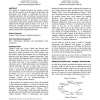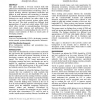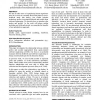OZCHI
2009
ACM
14 years 5 months ago
2009
ACM
The design of Tangible Interfaces has already evolved since the first projects were developed. Frameworks and taxonomies have helped to understand the field of Tangible Interactio...
OZCHI
2009
ACM
14 years 7 months ago
2009
ACM
Internet-based virtual worlds (VWs) have emerged as a popular form of collaborative virtual environment. Most have offered only text chat for user communication; however several V...
OZCHI
2009
ACM
14 years 7 months ago
2009
ACM
For many, an interest in Human-Computer Interaction is equivalent to an interest in usability. However, using computers is only one way of relating to them, and only one topic fro...
OZCHI
2009
ACM
14 years 7 months ago
2009
ACM
The OWL project is inspired by Arthur C. Clarke's Third Law of Technology Prediction: Any sufficiently advanced technology is indistinguishable from magic. It consists of a s...
OZCHI
2009
ACM
14 years 7 months ago
2009
ACM
Millions of people in Canada have impairments that result in a loss of function and directly affect their ability to carry out activities of daily living. Many individuals with di...
OZCHI
2009
ACM
14 years 7 months ago
2009
ACM
This paper describes a two-year research study that piloted and evaluated the use of low-cost, low-bandwidth Information and Communications Technology (ICT) to support meetings be...
OZCHI
2009
ACM
14 years 7 months ago
2009
ACM
This paper reflects on the HCI community’s current and potential contributions to the problem of promoting physical activity. It does so by first presenting a conceptual overvie...
OZCHI
2009
ACM
14 years 7 months ago
2009
ACM
We aim to make sense of a perplexing human experience (fun) as it occurs in a recently discovered place for sociotechnical study (the home). Our toolkit includes technology probes...
OZCHI
2009
ACM
14 years 7 months ago
2009
ACM
People use a wide range of intensity when interacting with computers, spanning from subtle to brute force. However, computer interfaces so far have mainly focused on interactions ...
OZCHI
2009
ACM
14 years 7 months ago
2009
ACM
More and more services are available on public terminals. Due to their public location and permanent availability, they can easily fall victim to manipulation. These manipulations...




